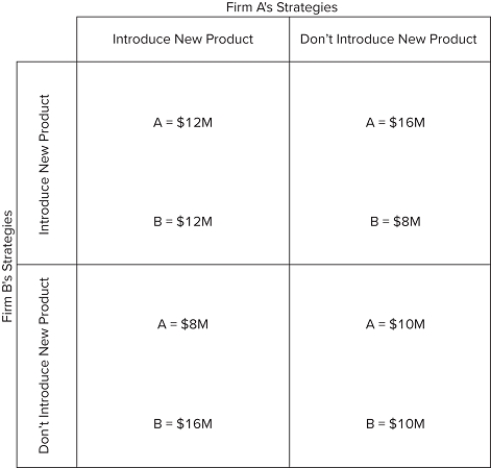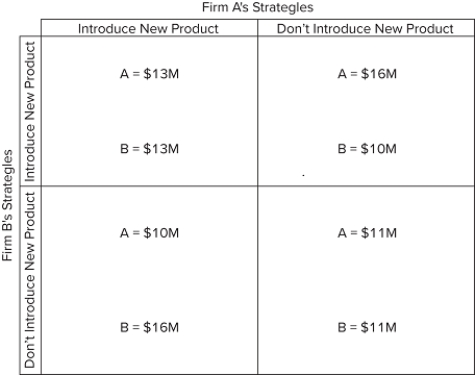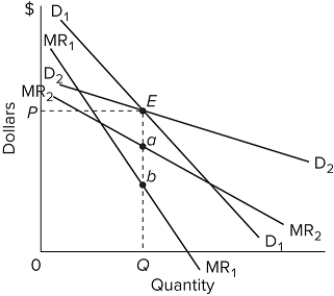A) pure monopoly.
B) oligopoly.
C) monopolistic competition.
D) pure competition.
Correct Answer

verified
Correct Answer
verified
Multiple Choice
 Answer the question based on the payoff matrix for a duopoly, in which the numbers indicate the profit from following either an international strategy or a national strategy. Which of the following is true?
Answer the question based on the payoff matrix for a duopoly, in which the numbers indicate the profit from following either an international strategy or a national strategy. Which of the following is true?
A) The international strategy is the dominant strategy for both firms.
B) The national strategy is the dominant strategy for both firms.
C) The international strategy is the dominant strategy for firm A, and the national strategy is the dominant strategy for firm B.
D) The national strategy is the dominant strategy for firm A, and the international strategy is the dominant strategy for firm B.
Correct Answer

verified
Correct Answer
verified
Multiple Choice
Advertising can impede economic efficiency when it
A) reduces entry barriers.
B) reduces brand loyalty.
C) leads to greater monopoly power.
D) provides consumers with useful information about product quality.
Correct Answer

verified
Correct Answer
verified
Multiple Choice
The study of how people (or firms) behave in strategic situations is called
A) cost-benefit analysis.
B) recursive analysis.
C) normative economics.
D) game theory.
Correct Answer

verified
Correct Answer
verified
Multiple Choice
If an industry evolves from monopolistic competition to oligopoly, we would expect
A) the four-firm concentration ratio to decrease.
B) the four-firm concentration ratio to increase.
C) the four-firm concentration ratio to remain the same.
D) barriers to entry to weaken.
Correct Answer

verified
Correct Answer
verified
Multiple Choice
A major reason that firms form a cartel is to
A) reduce the elasticity of demand for the product.
B) enlarge the market share for each producer.
C) minimize the costs of production.
D) maximize joint profits.
Correct Answer

verified
Correct Answer
verified
Multiple Choice
Which of the following best describes a Nash equilibrium?
A) An outcome from which one or both competitors can improve their position by adopting an alternative strategy.
B) The unstable outcome of a repeated game.
C) An outcome that is stable only because of credible threats.
D) An outcome that both competitors see as optimal, given the strategy of their rival.
Correct Answer

verified
Correct Answer
verified
True/False
Unlike a monopoly, an oligopoly tends to achieve allocative efficiency due to the rivalry among several firms.
Correct Answer

verified
Correct Answer
verified
True/False
Negative-sum games do not exist, because neither player has an incentive to play the game.
Correct Answer

verified
Correct Answer
verified
Multiple Choice
The characteristic most closely associated with oligopoly is
A) easy entry into the industry.
B) a few large producers.
C) product standardization.
D) no control over price.
Correct Answer

verified
Correct Answer
verified
Multiple Choice
Two characteristics of oligopoly pricing that have frequently been observed are that
A) oligopolistic prices tend to be "sticky" or inflexible, and when the firms do change their prices, they tend to do so together.
B) oligopolistic firms' prices tend to fluctuate a lot, and these prices tend to move together with each other.
C) oligopolists tend to practice a lot of price discrimination, and there tends to be a wide variance in oligopoly pricing.
D) oligopolistic firms' prices tend to fluctuate a lot, and there tends to be a wide variance in oligopoly pricing.
Correct Answer

verified
Correct Answer
verified
Multiple Choice
Assume six firms composing an industry have market shares of 35, 25, 15, 10, 10, and 5 percent. The Herfindahl index for this industry is
A) 2,175.
B) 2,300.
C) 1,225.
D) 85.
Correct Answer

verified
Correct Answer
verified
Multiple Choice
Answer the question based on the payoff matrices for a repeated game involving two firms that are considering introducing new products to the market. The numbers indicate the profit from following either a strategy to introduce a new product or a strategy to not introduce a new product.First game.  Second game.
Second game.  In the second game,
In the second game,
A) introducing a new product is the dominant strategy for both firms.
B) not introducing a new product is the dominant strategy for both firms.
C) introducing a new product is the dominant strategy for firm A, while not introducing a new product is the dominant strategy for firm B.
D) not introducing a new product is the dominant strategy for firm A, while introducing a new product is the dominant strategy for firm B.
Correct Answer

verified
Correct Answer
verified
Multiple Choice
Collusion refers to a situation where rival firms decide to
A) compete aggressively against each other.
B) cheat on each other.
C) agree with each other to set prices and output.
D) combine their operations and merge with each other.
Correct Answer

verified
Correct Answer
verified
True/False
The U.S. breakfast cereal industry is an example of differentiated oligopoly.
Correct Answer

verified
Correct Answer
verified
Multiple Choice
A prediction from the kinked demand curve model of oligopoly is that, for an individual firm, small changes in
A) demand will lead to changes in price or output.
B) marginal revenue will lead to changes in price and output.
C) marginal cost will lead to changes in price and output.
D) marginal cost will not lead to changes in price or output.
Correct Answer

verified
Correct Answer
verified
True/False
Mutually cancelling advertising by oligopolistic firms tends to improve economic efficiency in the industry.
Correct Answer

verified
Correct Answer
verified
Multiple Choice
If competing oligopolists completely ignore oligopolist X's price changes, then X's
A) demand curve will be less elastic than if the other oligopolists matched X's price changes.
B) demand curve will be more elastic than if the other oligopolists matched X's price changes.
C) marginal revenue curve will have a vertical gap.
D) demand and marginal revenue curves will coincide.
Correct Answer

verified
Correct Answer
verified
True/False
OPEC functions as a classic example of a kinked demand curve oligopoly.
Correct Answer

verified
Correct Answer
verified
Multiple Choice
 Refer to the diagram for a non-collusive oligopolist. Suppose that the firm is initially in equilibrium at point E, where the equilibrium price and quantity are P and Q. Which of the following statements is correct?
Refer to the diagram for a non-collusive oligopolist. Suppose that the firm is initially in equilibrium at point E, where the equilibrium price and quantity are P and Q. Which of the following statements is correct?
A) Demand curve D₁ assumes that rivals will match any price change initiated by this oligopolist.
B) Demand curves D₁ and D₂ both assume that rivals will ignore any price change initiated by this oligopolist.
C) Demand curves D₁ and D₂ both assume that rivals will match any price change initiated by this oligopolist.
D) Demand curve D₂ assumes that rivals will match any price change initiated by this oligopolist.
Correct Answer

verified
Correct Answer
verified
Showing 141 - 160 of 362
Related Exams